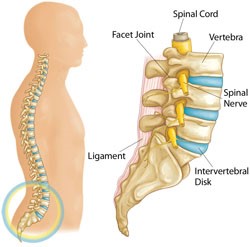
At one point in time or another, everyone will experience pain in their lower back. Pain can range from mild to intense. It can be either short-lived or long-lasting. Regardless of how it happens, lower back pain makes many of the everyday activities quite difficult to perform.
Osteoarthritis (OA) should simply be thought of as wear and tear. Everybody suffers OA to some extent, some people suffer more than others. Every joint will undergo some form of wear and tear, and the facet joints are no different.
Facet Joint Osteoarthritis Anatomy
Your spine is composed of a number of small bones (vertebrae) that are stacked atop one another. These connections are known as facet joints. They are small flat bony connections of bone that join the vertebra above to the vertebra below. Ligaments, muscles, intervertebral disks and nerves are all additional components that make up the spine.
The bones join together to form a canal protecting the spinal cord. The spinal column is composed of three different sections that create a natural curve in the back: the lower back (lumbar), chest area (thoracic) and the curves of the neck (cervical). Vertebrae fused together make up the lower section of the spine (coccyx and the sacrum). Five lumbar vertebrae join together to connect the lower part of the spine (lumbar spine) to the pelvis.
Electrical cables (the spinal cord) travel through the canal and carry the messages between the muscles and the brain. Nerves branch outward from the spinal cord through the vertebrae openings. Ligaments and muscles provide you with stability and support for the spine and the upper part of the body. Strong ligaments join the vertebrae and make sure the spinal column stays in position. The facet joints are located between the vertebrae to provide the spine with movement.

What Causes Facet Joint OA?
- Age
- Excessive use (poor posture, highly active in sports especially compressive sports)
- Poor nutrition can lead to quicker arthritic changes
- Poor fitness levels
- Poor health generally, especially smoking can contribute
How to Treat Facet Joint Osteoarthritis:
- Physical Therapy
This type of treatment includes ice, heat, massage, electrical stimulation and ultrasound. Active therapies involve stretching, cardiovascular exercises and weight lifting. Exercising to help restore strength and motion for your lower back proves to be quite beneficial in alleviating pain.
- Lumbar support
A lumbar support can be used to help provide support to the facet joints. Commonly used supports are the corset types that you can wrap around the stomach and the back. Even though they are not always beneficial, many people have reported feeling stable and comfortable when wearing the brace. Generally their use should be short term, and most useful when performing heavy lifting or weights.
- Chiropractic / Osteopathic Treatment
Chiropractic and osteopathy and other forms of manual therapy treatments are provided using a number of different forms and techniques. A lot of patients have found relief from pain in their lower back when undergoing this type of treatment. Treatment is typically hands on and restores mobility to the spine and reduces inflammation.
- Disk Replacement
When discs wear, they reduce in height and hence approximate the facet joints. This particular procedure involves take the disk and replacing it with an artificial one, such as that of a knee or hip replacement. The main goal is to allow the spinal component to maintain some degree of flexibility and maintain a normal range of motion. Surgery is done through the abdomen on one of the two lower disks of the spine. This can help maintain the gap between the facet joints.
Tips:
- Make sure to lift any heavy items with your legs and not your back.
- Smoking and nicotine cause the spine to age a lot quicker than normal.
- To avoid future problems, you need to maintain good posture.
- Combining aerobic exercise with specific types of exercises will help make sure the muscles in the abdomen and back flexible and strong.
- Maintaining a healthy weight alleviates stress on the lower part of the back.
- If you are in a job that involves a lot of manual labour or lifting, be sure to use a lumbar support belt to offload pressure on your spine.
Sign Up
Sign up for your free trial now!
Get started with Rehab My Patient today and revolutionize your exercise prescription process for effective rehabilitation.
Start Your 14-Day Free Trial